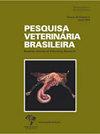Toxoplasma gondii, Neospora caninum and Sarcocystis spp. in species of naturally infected birds
IF 0.8
4区 农林科学
Q3 VETERINARY SCIENCES
引用次数: 1
Abstract
ABSTRACT: Toxoplasma gondii, Neospora caninum and Sarcocystis spp. are parasites detected in tissues of domestic and wild animals. Birds are relevant in the life cycle and epidemiology of protozoa due to the wide variety of bird species, feeding and migratory habits. The aim of this study was the molecular detection of T. gondii, N. caninum and Sarcocystis spp. in several species of naturally infected birds. Therefore, samples of brain and heart tissue were collected from birds received and necropsied at the Central Laboratory for the Diagnosis of Avian Pathologies (LCDPA), undergoing DNA extraction and amplification by the polymerase chain reaction (PCR) of the 18S rRNA gene to Sarcocystis spp., NC5 gene for N. caninum and repetitive gene 529 base pairs for T. gondii. N. caninum was detected in two birds (02/65, 3.07%), in a brain sample of Rupornis magnisrostris (accession number: ON182081, 267pb) and in a brain and heart sample of Dendrocygna bicolor (accession number: ON211312, 267pb). DNA of the genus Sarcocystis was detected in three birds (03/65, 4.62%), and in the genetic sequencing Sarcocystis spp. (accession number: MW463929) in brain of Nymphicus hollandicus and Sarcocystis speeri (accession number: MW464125) in brain and heart of Amazona aestiva. Phylogenetic analysis revealed that Sarcocystis spp. formed a clade with Sarcocystis spp. that use skunk (Didelphis aurita) as definitive host and Sarcocystis falcatula that use Moluccan loris (Trichoglossus moluccanus) as intermediate host. S. speeri formed a clade with S. speeri that used Mus musculus as an experimental intermediate host and formed a clade with Sarcocystis columbae, Sarcocystis corvusi, Sarcocystis halieti and Sarcocystis sp. that affect bird species. T. gondii DNA was not detected in any tissue. This is the first report of DNA detection of N. caninum, Sarcocystis spp. and S. speeri in tissue samples for these bird species extending the list of intermediate hosts.刚地弓形虫、犬新孢子虫和肉囊虫在自然感染鸟类中的分布
摘要:刚地弓形虫、犬新孢子虫和肉囊虫是在家养和野生动物组织中检出的寄生虫。由于鸟类种类繁多、摄食和迁徙习性多样,鸟类与原生动物的生命周期和流行病学密切相关。本研究的目的是在几种自然感染的鸟类中检测刚地弓形虫、犬奈瑟虫和肉囊虫。因此,我们在禽病诊断中心实验室(LCDPA)采集并尸检的禽类脑组织和心脏组织样本,进行DNA提取和聚合酶链反应(PCR),分别对Sarcocystis spp.的18S rRNA基因、N. caninum的NC5基因和弓形虫的529碱基对重复基因进行扩增。在2只鸟(02/65,3.07%)、一份magnisrostris鹭脑样本(登记号:ON182081, 267pb)和一份双色石斛脑和心脏样本(登记号:ON211312, 267pb)中检出犬乳杆菌。在3只鸟类(03/65,4.62%)中检测到肉囊菌属DNA,在荷兰小蛱蝶(nyphicus hollandicus)脑中检测到肉囊菌属(Sarcocystis spp.),在亚马逊河(Amazona aestiva)脑和心脏中检测到肉囊菌属(Sarcocystis speeri)基因测序(accession number: MW463929)。系统发育分析表明,肉囊虫属与以臭鼬(Didelphis aurita)为终寄主的肉囊虫属和以Moluccan loris (Trichoglossus moluccanus)为中间寄主的falcatula肉囊虫属形成一个分支。S. speeri与以小家鼠为实验中间宿主的S. speeri形成了一个分支,与影响鸟类的柱状肌囊虫、corvusi肌囊虫、halieti肌囊虫和Sarcocystis sp.形成了一个分支。未在任何组织中检测到弓形虫DNA。这是首次在这些鸟类的组织样本中检测到犬奈尔菌、肉囊菌和牛奈尔菌的DNA,扩大了中间宿主的范围。
本文章由计算机程序翻译,如有差异,请以英文原文为准。
求助全文
约1分钟内获得全文
求助全文
来源期刊

Pesquisa Veterinaria Brasileira
农林科学-兽医学
CiteScore
1.30
自引率
16.70%
发文量
41
审稿时长
9-18 weeks
期刊介绍:
Pesquisa Veterinária Brasileira - Brazilian Journal of Veterinary Research (http://www.pvb.com.br), edited by the Brazilian College of Animal Pathology in partnership with the Brazilian Agricultural Research Organization (Embrapa) and in collaboration with other veterinary scientific associations, publishes original papers on animal diseases and related subjects. Critical review articles should be written in support of original investigation. The editors assume that papers submitted are not being considered for publication in other journals and do not contain material which has already been published. Submitted papers are peer reviewed.
The abbreviated title of Pesquisa Veterinária Brasileira is Pesqui. Vet. Bras.
 求助内容:
求助内容: 应助结果提醒方式:
应助结果提醒方式:


